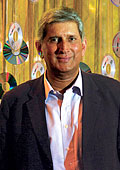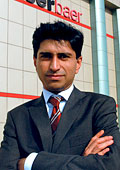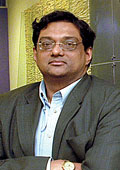 |
"When we started,
we were laggards-6-9 months behind the world. Today, we are
ahead of the world"
Deepak Puri
Managing Director/ Moser Baer |
Every
minute, seven compact discs roll off the manufacturing line at
Moser Baer's (MB's) Greater Noida optical storage plant. The machines
hum with metronomic precision, beating raw polycarbonate into
optical storage discs. This is high-tech, capital intensive manufacturing
that is Moser Baer's forte. The 24-year-old Delhi-based company
is the second-largest manufacturer of optical storage devices
(read: CDs and DVDs) in the world; the largest is Taiwan's CMC
Magnetics Corporation.
Emerging from a prolonged downturn in its
core business, Moser Baer is now crafting a strategy to diversify
and expand in line with Founder and Managing Director Deepak Puri's
vision of growing into an engineering- and technology-driven business.
"The transformation is about growing from a single-product
manufacturing company to a conglomerate with multiple high-growth
businesses," says Executive Director Ratul Puri. The goal:
ramp up each of these modules into $500 million (Rs 2,150 crore)
to $1 billion (Rs 4,300 crore) businesses. The company has also
transformed itself into a technological leader. Says Deepak Puri:
"When we started (in the optical media business), we were
laggards-6-9 months behind the world. Today, we are ahead of the
curve."
The evidence? Moser Baer is at the cutting
edge of emerging optical formats in storage-Blu-ray discs and
high density DVDs or HD DVDs. MB was the first to market the HD
DVDs, selling the initial batches at prices as high as $8 (then
Rs 360) apiece in August 2006. The price is now down to $7 (Rs
301) apiece. MB's recent acquisition of OM&T, a fully-owned
subsidiary of the Netherlands-based Philips, puts it at the forefront
of Blu-ray format as well. "OM&T is the only manufacturer
outside of Japan to be shipping Blu-ray discs," says Puri
Senior. This over-riding emphasis on being ahead of the technology
curve is helping the company keep its leadership position in its
core business. But the scenario wasn't this bright even two years
ago.
THE MOSER BAER MATRIX
The company's business portfolio will
look very different in a few years. |
BUSINESSES: Optical
storage
REVENUE SHARE: 30-33%
STRATEGY: It is a volume business and MB will leverage
its position as one of the lowest-cost producers in the world.
BUSINESSES: Entertainment
REVENUE: 20%
STRATEGY: To acquire 10,000-12,000 movie titles and
price them low.
BUSINESSES: Photovoltaic
REVENUE: 40%
STRATEGY: It is betting on 4-5 already proven technologies.
BUSINESSES: New businesses
REVENUE: 10-odd%
STRATEGY: not disclosed.
|
Moser Baer reported a net loss of Rs 11.15
crore in the April-June quarter of 2005-06 (it showed a profit
for the full year, though). Severe global pricing pressures coupled
with competition from other low-cost producers and rising raw
material prices eroded the exceptional returns that the industry
was known for. Though the downturn was not unexpected, its duration
and severity came as a rude shock.
Ashish Dhawan, Senior Managing Director of
private equity firm ChrysCapital, which invested in Moser Baer
during this downturn, says: "The downturn lasted longer than
any of us had anticipated." Cost efficiencies helped sustain
Moser Baer during this phase. It was also a period of learning,
and the lessons were immediately implemented. Ratul recounts that
despite the downturn, the company continued pumping funds into
the business. Over the last four years, Moser Baer has invested
over $1 billion (Rs 4,300 crore) and a large chunk of this has
been spent on climbing up the technology curve.
MB'S PHOTOVOLTAIC GAMBIT
The company is straddling a range of
PV technologies and is investing in the following: |
»
Crystalline Silicon-based PV Technology: Moser
Baer Photo Voltaic (MBPV), a subsidiary, is setting up a PV
cell and module manufacturing project with an 80 MW capacity
in India's first renewable energy SEZ at Greater Noida, UP.
The trial runs are complete and commercial production (40
MW) will start soon. The investment: Rs 260 crore. Subsequent
capacity increases will be in tranches of 80 MW each. The
integrated manufacturing line will lead to higher efficiency.
» Thin
Film Technology: MB is building the world's largest (200 MW)
thin-film solar fab in partnership with the US-based Applied
Materials. It plans sub-strates (bases) as large as 5.72 sq
m. The largest substrate used till date is 1.2 sq m. It will
invest Rs 1,000 crore on this over the next 3-4 years and
expects to have 40 MW capacity on stream by the end of this
year. Eyes initial revenues of $100 million.
» High
Concentrator Technology: It has small capacities at its Greater
Noida plant and will install about 900 panels (10-20 MW) in
a PV farm in Spain by September 2007. The technology is being
sourced from SolFocus, a recent investment.
» Low
Concentrator Technology: The technology from Solaria is a
force multiplier on C-Si (crystalline Silicon). Plans graded
ramp-up starting with 25-30 MW in Q1 of 2008-09.
» Nanotechnology:
MB has a presence in this promising but still evolving technology
through Stion Corp, in which it owns a stake. |
As the downturn began petering out in early
2006, the hugely capital-intensive blank optical storage business
again showed promise of generating massive amounts of free cash.
"A year ago, we felt that over the next three years, the
blank optical business would generate around $500 million (Rs
2,150 crore) of cash," says Ratul. So, an expansion and diversification
was clearly in order. The big question was: in which industries?
"Part of that free cash will be deployed in businesses that
are adjacent to our existing business. Synergies will have to
come from marketing, distribution, manufacturing and research
and development," says Ratul.
 |
"The transformation
is about growing a single-product firm into a conglomerate
with high-growth businesses"
Ratul Puri
Executive Director/ Moser Baer |
This decided, the debate then shifted to Moser
Baer's competencies. Yogesh B. Mathur, Group CFO, explains: "The
investment areas had to be high-growth, high-technology industrial
sectors where Moser Baer's competencies could make a difference."
(see The Moser Baer Matrix)
The photovoltaic (PV) space-where solar PV
arrays are used to convert the sun's energy into electricity-was
an obvious choice "as the skills required here are very similar
to those in the optical media (OM) business," says Rajesh
Khanna, Managing Director, Warburg Pincus, which invested in the
company in 2000. However, as Puri points out, globally, the industry
is driven by government subsidies; this makes for a difficult
operating environment. More importantly, there were internal differences;
son Ratul had reservations about the PV foray. "However,
he was convinced by the numbers," the father recounts.
The next problem that emerged was the span
of technologies prevailing in the PV market. Here, MB has placed
calculated technology bets. It has acquired minority stakes in
PV companies focussed on different spheres of the technology.
"Moser Baer and Germany's Q-Cells are probably the only two
PV companies that have a strategy of spreading the technology
risk over multiple investments," says Jeff Osborne, alternate
energy analyst with CIBC World Markets, a Canada-based research
firm. This gives the company an IPR exposure to developments in
different technologies and also makes it the manufacturer of choice
for these tech companies, helping it stay ahead of the curve.
 |
"The core business is
quite capital-intensive. The newer businesses are less so"
Yogesh B. Mathur
CFO/ Moser Baer |
Even as it scouted around for emerging technologies
in its chosen space, the company began building a crystalline
silicon (C-Si)-based plant at its renewable energy Special Economic
Zone in Greater Noida. This technology is proven and currently
dominates the PV market with over an 80 per cent market share.
The c-Si plant is expected to start commercial production any
time now, even as work on the thin film plant carries on at a
fast and furious pace (see MB's Photovoltaic Gambit). All the
bets may not pay off, but Ravi Khanna, Head (PV Business), points
out: "You have to participate in technology development,
not wait for the outcome."
The upsides are huge as seen from the valuations
of listed PV firms-ranging from price-earnings multiples from
the high teens to 30s-40s. Q-Cells, listed on the Frankfurt Stock
Exchange, has been trading at 25 times its estimated 2007 earnings.
Significantly, MB's share price has almost doubled in the last
one year from a low of Rs 162 to over Rs 300.
Another obvious diversification was a forward
integration of the storage business into the home entertainment
content (read: movies) business. "Though more closely aligned
to the core business, entertainment has been a bigger diversification
for the company," says ChrysCap's Dhawan.
Rampant piracy, a fragmented content market,
coupled with high prices for licensed end products (Rs 150-350)
had been the bane of several organised players. Moser Baer's unique
selling proposition in this field was the price of the licensed
software-Rs 28 for a cd and Rs 34 for a dvd. The result was astounding-two
million pieces were sold within 48 hours of its launch in Tamil
Nadu in December. These were numbers that the established players
were clocking in a year. Now, MB is putting in place a distribution
model along the lines of an FMCG company. "If a movie is
available at the price of a chocolate, then it should be as easily
available as well," says Harish Dayani, CEO, Entertainment
Business.
A FLURRY OF ANNOUNCEMENTS
Moser Baer has had a lot to tell the
world over the last year. |
| March 30: Moser Baer Photovoltaic
(MBPV) acquires 40 per cent stake in Slovenia-based Solarvalue
Proizvodnja D.D. for assured supply of high-grade solar-grade
silicon.
February 6: MB announces acquisition of OM&T
B.V., a highly specialised optical R&D company, which
was a 100 per cent subsidiary of the Netherlands-based Philips.
December 21: Announces launch of the content distribution
(home video) initiative, marking its maiden foray into the
entertainment industry.
November 29: Launches Moser Baer range of USB flash
drives in the Indian market.
October 3: Technology that it developed in-house
shortlisted as one of the four standard media to be included
in the Blu-ray disc specifications.
August 29: Gets board approval to invest an additional
$17 million (Rs 73 crore) in MBPV, its wholly-owned subsidiary
in the photovoltaic industry.
July 25: Begins shipping HD DVD-R (recordable),
a next generation format, to its global OEM customers.
|
Moser Baer has unobtrusively been buying
intellectual property and now owns, or has exclusive licences
to, 7,000 titles across languages, and plans to ramp up this number
to 10,000-12,000 films over the next few years at a cost of Rs
430 crore. The margins are wafer thin, but like its core business,
this, too, is a volumes game.
 |
| State-of-the-art: MBPV's solar cell
line at Greater Noida |
Driving prices lower through larger volumes
seems to be the leitmotif across the entire spectrum of businesses
for Moser Baer. However, there is a critical difference as Mathur
explains: "The core business is quite capital-intensive.
The newer businesses are less so." For instance, the optical
media business had an asset-turnover ratio of 0.6-0.7-60-70 paise
of turnover for every rupee of capital invested-till a couple
of years ago. This has improved to 1-2. In the entertainment and
PV businesses, it is as much as 3-7.
All this might well sound like a mad and
frightening rush towards diversification. But there is a method
in the madness. Mathur points to the 3M model of diversification-into
seemingly disparate industries linked by a set of core competencies.
John Levack, MD, Electra Partners, one of the earliest private
equity investors in Moser Baer, says: "The approach seems
quite sensible."
The dreams are ambitious, but Ratul is clear
that "nobody can doubt our execution capabilities".
The big picture is in place and so are several of the smaller
pieces. Now, Puri and his team has to string them together.
|








